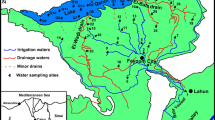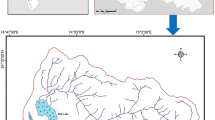Abstract
Maharlu Lake with Na–Cl water type is the terminal point of a closed basin in southern Iran. A total of 10 water samples from two rivers discharging to the lake and 78 water samples of surface and pore brine of Maharlu Lake have been collected from different depths (surface, 20, 50 and 100 cm) of four sampling stations along the lake during a period of lake water-level fluctuation (November 2014–July 2015). To investigate chemical interaction between lake surface water and shallow pore water and to understand the major factors governing chemical composition of Maharlu brine, concentrations of major and minor (boron, bromide and lithium) solutes, pH and total dissolved solids have been measured in collected water samples. Saturation indices of evaporite minerals in collected water samples have been also calculated. The chemical behavior of dissolved solutes and evaporative evolution of the lake brine during a hydrological period have been simulated using PHREEQC. The results of our investigations indicated that chemical composition of lake surface water and pore brine of Maharlu Lake are mainly connected with lake water-level fluctuations and distance from input rivers (and depth), respectively. Hydrochemical investigations and statistical analysis showed that the brines chemistry of Maharlu is mainly controlled by three processes: brine evaporative evolution, dissolution–precipitation and diagenetic evolution of secondary carbonates.











Similar content being viewed by others
References
Abdel Wahed MSM, Mohamed EA, El-Sayed MI, M’nif A, Sillanpää M (2015) Hydrogeochemical processes controlling the water chemistry of a closed saline lake located in Sahara Desert: Lake Qarun, Egypt. Aquat Geochem 21:31–57
Anderson RB, Naftz DL, Day-Lewis FD, Henderson RD, Rosenberry DO, Stolp BJ, Jewell P (2014) Quantity and quality of groundwater discharge in a hypersaline lake environment. J Hydrol 512:177–194
APHA (1998) Standard methods for the examination of water and wastewater, 20th edn. American Public Health Association, Washington
Appelo CAJ, Postma D (2005) Geochemistry, groundwater and pollution. Balkema, Leiden, The Netherlands, p 647
Deocampo DM, Jones BF (2014) Geochemistry of Saline Lakes. In: Drever JI (ed) Treatise on Geochemistry, vol 7, 2nd edn. pp 437–469. https://doi.org/10.1016/B978-0-08-095975-7.00515-5
Eugster HP, Hardie LA (1978) Saline lakes. In: Lerman A (ed) Lakes: chemistry, geology, physics. Springer, New York, pp 237–293. https://doi.org/10.1007/978-1-4757-1152-3_8
Eugster HP, Jones BF (1979) Behavior of major solutes during closed-basin brine evolution. Am J Sci 279:609–631
Fars Water Resources Organisation (1995) Geophysical Investigation of Alaodolleh Dam Report, p 61 (in Farsi)
Hardie LA, Eugster HP (1970) The evolution of closed-basin brines. Mineral. Soc. Am. Spec. Pap. 3:273–290
Herczeg AL, Lyons WB (1991) A chemical model for the evolution of Australian sodium chloride lake brines. Palaeogeogr Palaeoclimatol Palaeoecol 84:43–53. https://doi.org/10.1016/0031-0182(91)90034-O
Jahanshahi R, Zare M (2016) Hydrochemical investigations for delineating salt-water intrusion into the coastal aquifer of Maharlou Lake, Iran. J African Earth Sci 121:16–29
Johnson M (1980) The origin of Australia’s salt lakes. New South Wales Geol Surv 19:221–266
Jones BF, VanDenburgh AS, Truesdell AH, Rettig SL (1969) Interstitial brines in playa sediments. Chem Geol 4:253–262
Kaiser HF (1958) The varimax criterion for analytic rotation in factor analysis. Psychometrika 23:187–200
Kazemi M, Feisnia S, Khosravi H, Mesbah H (2016) Investigation of quantitative changes and direction of groundwater flow in Maharloo area. In: 2nd Int. Conf. Sustain. Dev. Solut. Challenges Focus. Agric. Nat. Resour. Environ. Tour
Khosravi R (2018) Distribution of arsenic in surface/subsurface water interface of hypersaline lakes, Case study: Maharlu Lake, Fars Province-Iran. Ph.D. Dissertation, Shiraz University
Kolpakova MN, Gaskova OL (2017) Major ions behaviour during evaporation of different saline type water of Western Mongolian lakes (geochemical modelling). Hydrol Res 49:163–176. https://doi.org/10.2166/nh.2017.148
Kouchekzadeh A, Zarei M (2017) Introducing hydrochemical diagnostic tools to differentiate sources of salinity, Southern Iran. Int J Water 11:226–250
Krinsley DB (1974) The utilization of ERTS-1 generated images in the evaluation of some Iranian Playas as sites for economic and engineering development, part 1
Lerman A (2009) Saline Lakes’ response to global change. Aquat Geochem 15:1–5
Lerman A, Jones BF (1973) Transient and steady-state salt transport between sediments and brine in closed lakes. Limnol Oceanogr 18:72–85. https://doi.org/10.4319/lo.1973.18.1.0072
Mehdizadeh R, Zarei M, Raeisi E (2015) How subaerial salt extrusions influence water quality in adjacent aquifers. J Hydrol 531:1108–1113
Müller G, Irion G, Förstner U (1972) Formation and diagenesis of inorganic Ca–Mg carbonates in the lacustrine environment. Naturwissenschaften 59:158–164. https://doi.org/10.1007/BF00637354
Najmodini H (2011) Investigation of temporal and spatial variations of heavy metals in Maharlu Lake and one of adjacent aquifers. Msc Dessertation, Shiraz University
Nekouei E, Zarei M (2017) Karst hydrogeology of Karmustadj salt diapir, southern Iran. Carbonates Evaporites 32(3):315–323
Nekouei E, Zarei M, Raeisi E (2016) The influence of diapir brine on groundwater quality of surrounding aquifers, Larestan, Iran. Environ Earth Sci 75(7):571. https://doi.org/10.1007/s12665-015-5237-2
Parkhurst DL, Appelo CAJ (2013) Description of Input and Examples for PHREEQC version 3—a computer program for speciation, batch-reaction, one-dimensional transport, and inverse geochemical calculations. U.S. geological survey techniques and methods, book 6, chapter A43, 497 p. U.S. Geol. Surv. Tech. Methods, B. 6, chapter A43 6, 6–43A. https://doi.org/10.1016/0029-6554(94)90020-5
Peryt TM, Kasprzyk A (1992) Carbonate–evaporite sedimentary transitions in the Badenian (middle Miocene) basin of southern Poland. Sediment Geol 76:257–271
Pitzer KS (1987) A thermodynamic model for aqueous solutions of liquid-like density. Rev Mineralogy and Geochem 17(1):97–142
Rosen MR (1994) The importance of groundwater in playas: a review of playa classifications and the sedimentology and hydrology of playas. Geol Soc Am Spec Pap 289:1–18
Salifu A, Petrusevski B, Ghebremichael K, Buamah R, Amy G (2012) Multivariate statistical analysis for fluoride occurrence in groundwater in the Northern region of Ghana. J Contam Hydrol 140:34–44
Shahrabi M (1994) Geology of Iran: seas and lakes. Geological Survey of Iran, Tehran
Sharaf MA, Illman DL, Kowalski BR (1986) Chemometrics. Wiley, New York
Shariati Bidar M (2001) Investigation and Exploration of Economic Elements of the Maharlu, Bakhtegan, Tashk Lakes, part 1, Geological Survey of Iran, p 223 (in Farsi)
Smoot JP, Lowenstein TK (1991) Depositional environments of non-marine evaporites. Dev Sedimentol 50:189–347
Spencer RJ, Eugster HP, Jones BF, Rettig SL (1985) Geochemistry of Great salt Lake, Utah I: hydrochemistry since 1850. Geochim Cosmochim Acta 49:727–737
Tajabadi M, Zare M, Alijani F (2017) Unstable convection flow as a controlling process of increasing salinity in the saline lake coastal aquifers: case of Maharlu Lake coastal aquifer. Environ Earth Sci 76:267
Torgersen T, De Deckker P, Chivas AR, Bowler JM (1986) Salt Lakes: a discussion of processes influencing palaeoenvironmental interpretation and recommendations for future study. Palaeogeogr Palaeoclimatol Palaeoecol 54:7–19. https://doi.org/10.1016/0031-0182(86)90115-X
Vega M, Pardo R, Barrado E, Debán L (1998) Assessment of seasonal and polluting effects on the quality of river water by exploratory data analysis. Water Res 32:3581–3592. https://doi.org/10.1016/S0043-1354(98)00138-9
Warren J (2000) Dolomite: occurrence, evolution and economically important associations. Earth Sci Rev 52:1–81. https://doi.org/10.1016/S0012-8252(00)00022-2
Yechieli Y, Wood WW (2002) Hydrogeologic processes in saline systems: playas, sabkhas, and saline lakes. Earth Sci Rev 58:343–365
Zabala ME, Manzano M, Vives L (2016) Assessment of processes controlling the regional distribution of fluoride and arsenic in groundwater of the Pampeano Aquifer in the Del Azul Creek basin (Argentina). J Hydrol 541:1067–1087. https://doi.org/10.1016/j.jhydrol.2016.08.023
Zak I, Gat JR (1975) Saline waters and residual brines in the Shiraz-Sarvistan basin, Iran. Chem Geol 16:179–188
Zarei M (2010) Hydrogeology of salt diapirs in the south of Iran. Ph.D. Dissertation, Shiraz University
Zarei M (2016) Factors governing the impact of emerged salt diapirs on water resources. Groundwater 54:354–362
Zarei M, Sedehi F, Raeisi E (2014) Hydrogeochemical characterization of major factors affecting the quality of groundwater in southern Iran, Janah Plain. Chemie der Erde-Geochemistry 74:671–680
Acknowledgements
This research was financially supported (partly) by Iran National Science Foundation.
Author information
Authors and Affiliations
Corresponding author
Appendix
Appendix
Rights and permissions
About this article
Cite this article
Khosravi, R., Zarei, M. & Bigalke, M. Characterizing Major Controls on Spatial and Seasonal Variations in Chemical Composition of Surface and Pore Brine of Maharlu Lake, Southern Iran. Aquat Geochem 24, 27–54 (2018). https://doi.org/10.1007/s10498-018-9329-y
Received:
Accepted:
Published:
Issue Date:
DOI: https://doi.org/10.1007/s10498-018-9329-y




